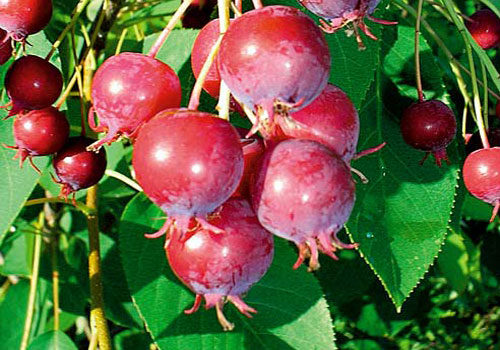Irga Canadian is a very interesting fruit and decorative culture. Deciduous shrub in height from 1.5 to 8 meters is beautiful at any time of the year. In the spring, an irga looks attractive during bud break, when it seems to be shrouded in silvery-white hoarfrost.
Later, during flowering, it is covered with bunches of fragrant white flowers surrounded by bees. Until mid-summer, shrubs adorn the brush of blue-purple berries. Until late autumn, the foliage is the decoration of the shrub, which gradually changes its color from green to purple. Against the backdrop of a snowy winter garden, maroon-brown branches look spectacular.
Table of contents
Canadian shadberry description
Let's begin, perhaps, with the description Irga is a fast-growing, skoroplodny shrub long-liver. In fruiting culture enters after planting in the third year. Life expectancy irgi 40-50 years. Frost resistance is excellent, with no losses tolerates frosts up to 40 degrees. In the conditions of the Moscow region for the winter does not need shelter. Feels good plant and in more northern areas. Well-growing bushes are very light-requiring and when too densely planted they stretch strongly upwards and do not bear fruit well.
Shrub root system is superficial, the bulk of the roots is located at a depth of 40 cm, some goes deeper to 1 m. The radius of propagation of the root system reaches 2 m.
Irga blooms in late April - early May, for 10-15 days. Flowers withstand short-term spring frosts down to -7 ° C.
The quality of the soil shrub is not demanding, drought-resistant. Irga grows quickly - in the third year after planting it begins to bear fruit, and at the age of 8-10 years, a period of full productivity begins.The period of productivity is 20-30 years with an average yield of 8-10 kg of berries from a bush.
Beneficial features
Irgi berries are a good multivitamin remedy containing vitamins C, B2, carotene, pectins, anthocyanins and trace elements (cobalt, copper, lead). The fruits are useful in the treatment of hypo-and avitaminosis, for the prevention and treatment of atherosclerosis, diseases of the gastrointestinal tract, the cardiovascular system.
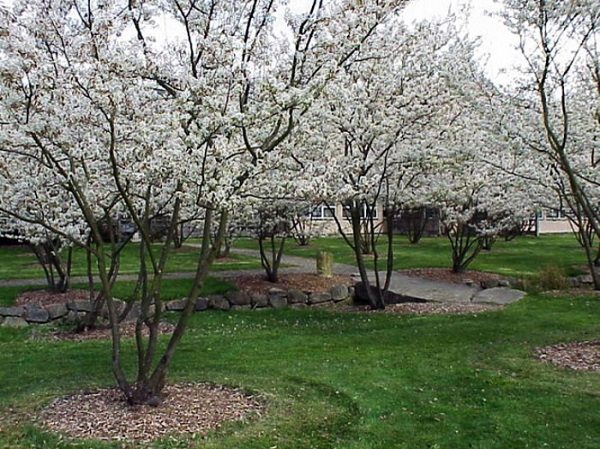
Medicinal properties of berries irgi
- soothe the nervous system, useful for insomnia and restless sleep;
- increase the elasticity of the walls of blood vessels and strengthen them;
- used for the prevention of myocardial infarction and varicose veins (prevents the formation of blood clots);
- have a tonic effect, lower high blood pressure and normalize cholesterol;
- used for the prevention of peptic ulcer and as an anti-inflammatory agent in the disorder of the gastrointestinal tract;
- useful berry in the fight against sclerosis;
- juice from fresh berries has astringent properties, so it is used to rinse the throat during its inflammation.
Types and variety of varieties
Irga is from the Rosaceae family and has more than 25 species. The most common ones are:
- Irga Canadian - shrub with drooping branches up to 6 meters high. It is appreciated for very sweet, tasty berries weighing up to 1 g. Productivity to 6 kg / bush. Green lush, very good in hedges when planting through 2 meters. This is a fast-growing shrub with an annual increase of up to 40 cm in height and width.
For the past 60 years, Canada has been the center of breeding for the best varieties of irgi. The most popular among gardeners are:
- Pembina - height and width of a bush reach 5 meters. Crown sprawling. The advantage of the variety is the formation of a small amount of root shoots.
- Smokey - shrub up to 4.5 m, crown as an open umbrella. A variety with a late flowering period, which makes it possible to avoid losing the ovary during late spring frosts. Smokey's berries have a large diameter of up to 14mm with a great aroma.The berries are the sweetest of all available varieties, fleshy and without astringency.
- Northline - Multiple medium bush, vertical trunks. The berries are very large, up to 16 mm in diameter, blue-black with a waxy bloom. The ripening of non-cracking berries is amicable. Variety forms a lot of root shoots. Needs pollinator.
- Sturgeon - Multiple sprawling shrub up to 3 m. The variety is high-yielding, berry tassels are long, the fruits are large and sweet.
- Thyssen - shrub reaching a height of 5 m with a highly sprawling rounded crown. It is the earliest, skoroplodny grade. The size of the berries of excellent taste reaches 17 mm in diameter. The fruit is fragrant with a slight sourness. Due to the uneven ripening of berries, the harvest period is extended in time. Frost resistance to - 28 ° C.
- Irga Lamarck - it is a large shrub or small tree up to 8 meters high. Crohn has a rounded shape. Unlike the Canadian irgi, it grows more slowly, the annual increment is no more than 25 cm in height. Irga Lamarck is very beautiful in the period of flowering and in the crimson decoration of foliage in the fall.
The trunks get a beautiful winding shape when performing regular shaping.Such trees look good in single plantings and alleys.
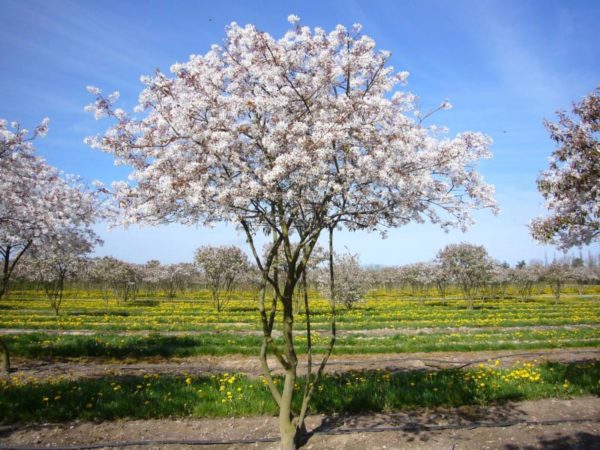
Planting, growing and care conditions
The conditions of growing irga undemanding, in the care is not capricious.
In the garden or on the plot, it can be planted on the north side, as its multi-trunk bushes trap snow and protect it from the cold north winds. Next to her, it is good to plant raspberries, currants, gooseberries, for them it will serve as a good defense.
Irga can be planted both in spring and autumn. In the prepared pit, seedlings are planted 5-10 cm deeper than they grew before, this will contribute to the growth of a larger number of basal shoots. After planting and abundant watering, the soil around the seedlings is mulched, the plant is cut about 1/3 of the height, leaving no more than 5 well-developed buds. Plants are planted after 2-3 m, and when creating a hedge it is preferable to plant them in a checkerboard pattern by 0.5-0.7 m in rows and between plants.
Further care is watering in dry periods, loosening the soil around the bushes and fertilizing. Irga is responsive to fertilizer. During the season it is advisable to feed it monthly with liquid organic fertilizers (infusions of mullein or bird droppings) combining them with watering and making foliar feeding with micronutrient fertilizers. The plant will thank you.
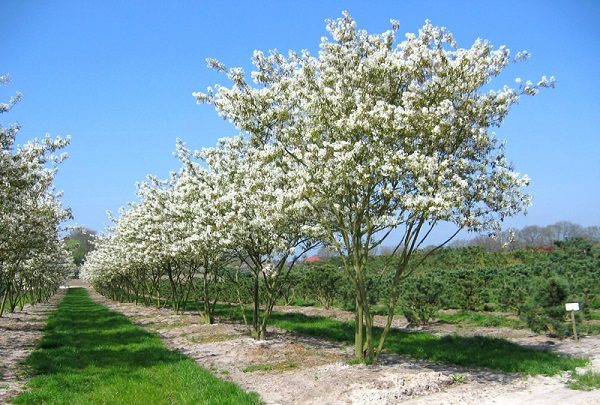
Pruning
If you decide to form a plant in the form of a multi-bush, in the first years after planting, it is necessary to remove all weak shoots leaving the 2-3 strongest zero shoots from the root shoots. A well-formed bush consists of 10 to 15 branches of different ages.
When the annual growth of shoots will be no more than 10 cm, proceed to the rejuvenating pruning, which consists in removing all weak and highly elongated shoots. The rest is cut to a height of 2.5 meters. All places of large sections surely need to be processed garden pitch.
Irgu Lamarck is formed by a tree with 3-5 trunks, the rest of all root shoots are removed during the whole season. The branches are shortened annually.
When using the Canadian shad to create a hedge it is necessary to cut it annually, shortening the annual growth by 10-15 cm. The annual pruning will contribute to better branching.
Breeding
Canadian propaganda can be propagated in several ways:
- Seeds. Seeds are harvested from large, ripe berries from the most productive bushes. Give the berries to lie down for a week, and then the seeds, when they are well separated from the pulp, are removed. The seeds are sown in the fall in the year of harvesting the seeds. Seeds are sown in furrows, well watered, covered with a film on top. When spring planting seeds, they must be stratified for 3 months in wet sand in the basement. With good care in the first year, seedlings can reach a height of 10-15 cm, for 2 years their height will be up to 40 cm, after 2 years the seedlings are transplanted to a permanent place.
- Root offspring. In this breeding method, basal shoots are used. It is separated from the parent bush and transplanted to a permanent place. Time transplant spring or autumn.
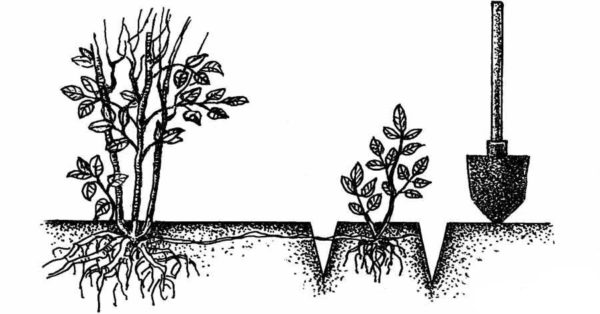
Reproduction irgi otprazkami - Green cuttings. Propagation of green cuttings in the Canadian irgi is quite successful. 95% of the shoots are rooted. Green cuttings are cut during the intensive growth of shoots from late June to the first decade of July. The cuttings are cut from the top of 5-6 summer branches, the cuttings should be 12-15 cm long. From the cut cuttings, the lower leaves are removed, leaving only two pairs of the upper ones. The lower cut of the cutting is processed in the root formers and planted obliquely at a distance of 5 cm from each other. The cuttings are planted in the greenhouse where it is necessary to maintain air humidity at a level of 70-80%. Rooting occurs for 20-25 days. After rooting, the film is removed, and the further growth of plants occurs in the open air. It is necessary to produce regular watering and dressing. In the spring of next year, the plants are ready for transplanting.
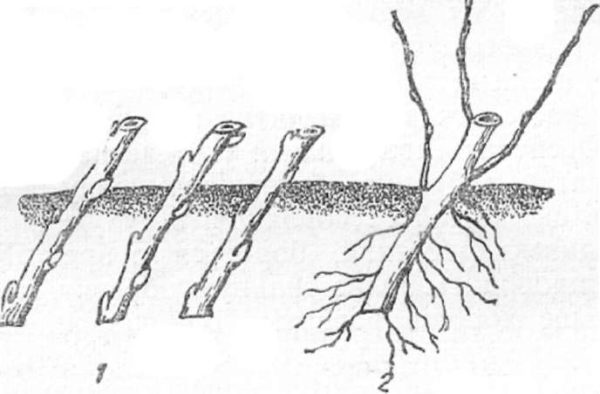
Reproduction irgi green cuttings - Reproduction by layering. With this breeding method, well-developed one or biennial branches are taken. Layers are best done in early spring, as soon as the soil allows. Near the bush make grooves in which the selected branches are laid.Stacked shoots pin to the ground with metal clips, shoot tops shorten. After regrowth from the buds of the designated branches of green shoots to a height of 10-12 cm, they are sprinkled with earth at half the height, and after 20 days the procedure of sprinkling with earth is repeated. In the fall, grown plants can be deposited in a permanent place.
- Reproduction by dividing the bush. This method is used when it is necessary to transplant an adult bush to another place. The plant is dug out, in early spring or late autumn, the roots are freed from excess earth, the old branches are removed. The iris root root is divided into parts, the roots are shortened and planted in prepared landing pits.

Pests and diseases
Irga Canadian is resistant to major fungal diseases and pests. It may be affected by the caterpillars of the currant leafworm, the caterpillar of the rosant leafworm. They harm the leaves and gnaw the tops of young shoots. For pest control in the processing of the garden you need to remember to spray the shad irgi.
During the ripening of the berries, birds cause great harm to her, who also love to feast on her juicy and tasty berries. In order to avoid yield loss, young bushes can be covered with a net.When the plants are already large, then the berries will be enough for everyone.
Vitamins - for the future
Irga bears fruit annually and abundantly, but its berries ripen unevenly and therefore they are harvested in several stages.
The shelf life of the harvested berries is small for only 2-3 days if stored in a cool place (basement or refrigerator).
Compote, juices, preserves, jelly, wine are made from the sweet berries of the irgi, dried and frozen. Berry irgi because of the low content of acid they do not have a bright taste, but they have a very bright color. In connection with what they are very good to add to compotes from apples, pears and other fruits that do not have a pronounced color.
Characteristic of the irgi is the poor return of juice from fresh berries. After 5-7 days of laying, the juice yield during processing will be up to 80%.
Blanks
Juice from irgi berries is good for eyes, heart, throat, vessels. Prepared juice is used to make fruit drinks, drinks, jelly.
Juice with sugar
Lying in a cool place for a week, the berries are washed, squeezed juice, mixed with sugar in a 1: 1 ratio. Heat the juice over low heat until the sugar is completely dissolved, not boiling. Heated juice is poured into glass jars or bottles, sealed and stored in a cool place.
Natural juice
From the prepared berries squeeze the juice, pour it into liter jars, pasteurized for 15-20 minutes and roll up the lids.
Irga Canadian due to its healing, taste and decorative qualities deserves an honorable place in the garden or in the country. Leaving is minimal, but there is an abundance of benefits and pleasures.
